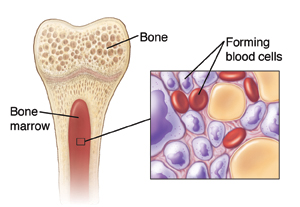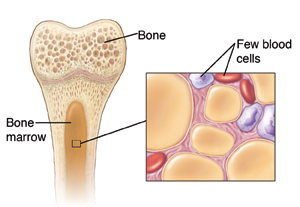When Your Child Has Aplastic Anemia
Aplastic anemia occurs when your child’s bone marrow doesn't make enough healthy blood cells. It's a serious condition that can be life-threatening without treatment. Your child’s healthcare provider can discuss treatment options with you.
 |
| Normally, bone marrow makes the blood cells needed to keep the body healthy. |
 |
| With aplastic anemia, the bone marrow makes too few healthy blood cells. |
What are blood cells?
-
Blood cells are made in the bone marrow. The bone marrow is the soft, spongy part inside bones. New blood cells are made daily. They help replace the cells that die naturally or that are lost from your body through injury or illness.
-
There are three types of blood cells: red blood cells (RBCs), white blood cells (WBCs), and platelets. RBCs contain a protein called hemoglobin. This protein allows them to carry oxygen to all parts of the body. WBCs help fight infections and illnesses. Platelets help with the clotting process to control bleeding from cuts or bruises. Each type of blood cell is needed to maintain overall health. In aplastic anemia, all three types of cells may be low.
What causes aplastic anemia?
Aplastic anemia can occur with no known cause. Exposure to radiation or certain toxic chemicals is thought to make it more likely. A viral infection, such as hepatitis, also makes it more likely. And certain autoimmune disorders or genetic conditions can sometimes trigger the condition.
What are the symptoms of aplastic anemia?
Some children have no symptoms. If symptoms are present, they may include
-
Pale skin
-
Crankiness
-
Weakness
-
Lack of energy (fatigue)
-
Shortness of breath
-
Trouble doing normal amounts of physical activity (exercise intolerance)
-
Rapid heartbeat
-
Dizziness or fainting
-
Fever
-
Recurrent or severe infections
-
Excessive bruising or bleeding
-
Ulcers in the mouth
How is aplastic anemia diagnosed?
Your child will likely see a pediatric hematologist for diagnosis and treatment. This is a healthcare provider who specializes in blood disorders (hematology). The healthcare provider will examine your child and ask about your child’s symptoms, medicines, diet, and family and health history. Tests may be done. Most of the tests are done by taking a blood sample from a vein in the arm or from a finger or heel. Tests may include:
-
Complete blood cell count (CBC). This measures the amounts of types of cells in the blood.
-
Blood smear. This checks the size and shape of blood cells. A drop of blood is looked at with a microscope. A stain makes parts of the blood cells easier to see.
-
Reticulocyte count. This measures the amount of new RBCs being made by the bone marrow.
-
Bone marrow aspiration and biopsy. These are done to check for problems with the production of blood cells. With a bone marrow aspiration, a needle is inserted into a bone to collect a sample of the bone marrow fluid and cells. With a bone marrow biopsy, a needle is inserted into a bone to collect a small sample of bone marrow tissue. The tests can be done separately. But they are often done together. They are typically done with sedation so that your child will not have too much pain.
How is aplastic anemia treated?
Treatment depends on the severity of your child’s symptoms and the possible cause. In mild to moderate cases, your child will likely need regular visits with the healthcare provider for routine checkups and blood tests. In severe cases, hospital care is needed. Treatment for aplastic anemia can include:
-
Blood transfusions. These are needed when your child’s blood cell count is too low. Transfusions of RBCs and platelets are common. It's rare for WBCs to be transfused.
-
Immunosuppressant medicines. In some cases, a problem with the immune system is responsible for injuring or destroying the blood cells. These medicines are given to reduce the strength of the body’s immune system.
-
Other medicines. These can include growth factors to help the body make more blood cells and antibiotics to help fight infections.
-
Bone marrow transplant. In rare cases, this procedure is done if the body can’t make enough healthy blood cells. It replaces diseased bone marrow cells with healthy cells from a matched donor.
What are the long-term concerns?
-
Children with mild to moderate aplastic anemia can learn to manage their condition so they can be as active and independent as possible. Discuss with your child’s healthcare provider how to help your child prevent possible complications. This includes topics such as physical activity, diet, and how to reduce the risk of bleeding or infections.
-
Children with severe aplastic anemia will need ongoing treatment and supportive care. Work closely with your child’s provider to learn how to help your child.
Where to find support
It’s helpful to keep a positive outlook while supporting your child. Think about going for counseling. This can help you and your child deal with any worries or concerns. And seek help from family, friends, community resources, or support groups. Many hospitals also have child life programs, which are designed to help children cope with their condition. A hospital social worker can also answer questions and refer you to other supportive services, if needed. The more you learn about your child’s condition and its treatments, the more in control you may feel.
Online Medical Reviewer:
Adam Levy MD
Online Medical Reviewer:
Dan Brennan MD
Online Medical Reviewer:
Jessica Gotwals RN BSN MPH
Date Last Reviewed:
12/1/2022
© 2000-2024 The StayWell Company, LLC. All rights reserved. This information is not intended as a substitute for professional medical care. Always follow your healthcare professional's instructions.